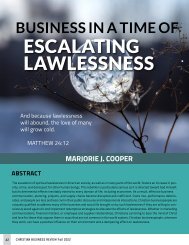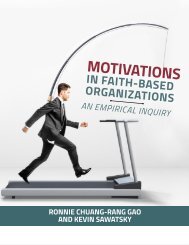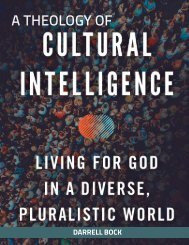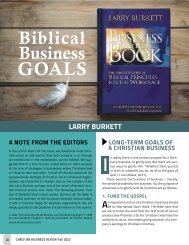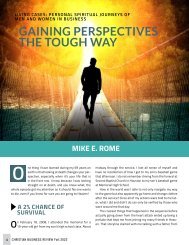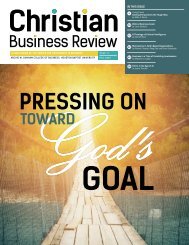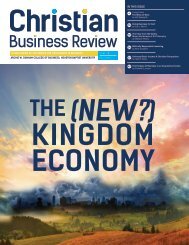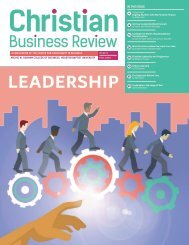Christian Business Review 2018: Kingdom Business in the Brave New World (Issue 7)
You also want an ePaper? Increase the reach of your titles
YUMPU automatically turns print PDFs into web optimized ePapers that Google loves.
communication technologies<br />
CBR articles<br />
11<br />
Genesis 9:6 and James 3:9<br />
12<br />
Mat<strong>the</strong>w 18<br />
13<br />
Mat<strong>the</strong>w 18:6, Luke 17:2, Mat<strong>the</strong>w 25:40<br />
14<br />
2 Cor<strong>in</strong>thians 5:18, “All this is from God, who reconciled us to<br />
himself through Christ and gave us <strong>the</strong> m<strong>in</strong>istry of reconciliation.”<br />
15<br />
C.S. Lewis, “The Weight of Glory,” Sermon delivered <strong>in</strong> <strong>the</strong><br />
Church of St Mary <strong>the</strong> Virg<strong>in</strong>, Oxford; repr<strong>in</strong>ted <strong>in</strong> Theology<br />
(November, 1941). Retrieved from: https://www.verber.com/<br />
mark/xian/weight-of-glory.pdf<br />
16<br />
Romans 12:18<br />
17<br />
Mayer, Roger C., James H. Davis & F. David Schoorman, “An Integrative<br />
Model of Organizational Trust,” The Academy of Management<br />
<strong>Review</strong> (20(3), 1995), 709-34. Accessed at http://www.<br />
jstor.org/stable/258792.<br />
18<br />
J.D. Lewis & A. Weigert, “Trust as a Social Reality,” Social<br />
Forces (63(4), 1985), 967-85.<br />
19<br />
Fernando Flores & Robert C. Solomon, “Creat<strong>in</strong>g Trust,” <strong>Bus<strong>in</strong>ess</strong><br />
Ethics Quarterly (8(2), 1998), 205.<br />
20<br />
Both David Gill and James Heskett make <strong>the</strong> case that trust<br />
is critical to build<strong>in</strong>g a healthy organizational culture, and that<br />
culture ultimately <strong>in</strong>fluences organizational outcomes; see<br />
David W. Gill, It’s About Excellence: Build<strong>in</strong>g Ethically Healthy<br />
Organizations (Executive Excellence Publish<strong>in</strong>g, 2008), and<br />
James Heskett, The Culture Cycle: How to Shape <strong>the</strong> Unseen Force<br />
that Transforms Performance, (Upper Saddle River, NJ: F<strong>in</strong>ancial<br />
Times Press, 2012).<br />
21<br />
Organizational communication scholars have described various<br />
characteristics of relationships, but as far as we are aware,<br />
<strong>the</strong>y have not been compiled <strong>in</strong> any systematic or commonly<br />
recognized way. For example, <strong>the</strong> Fundamental Interpersonal<br />
Relationships Orientation (FIRO) is a <strong>the</strong>ory and measure of an<br />
<strong>in</strong>dividual’s desired and expressed levels of <strong>in</strong>clusion, control,<br />
and openness <strong>in</strong> relationships; see W.C. Schutz, FIRO: A Three Dimensional<br />
Theory of Interpersonal Behavior (<strong>New</strong> York, NY: Holt,<br />
R<strong>in</strong>ehart, & W<strong>in</strong>ston, 1958). Also Brito et.al. describe group relationships<br />
<strong>in</strong> terms of <strong>the</strong>ir levels of communal shar<strong>in</strong>g, authority<br />
rank<strong>in</strong>g, and equality match<strong>in</strong>g; see Rodrigo Brito et.al., “The<br />
Contexts and Structures of Relat<strong>in</strong>g to O<strong>the</strong>rs: How Memberships<br />
<strong>in</strong> Different Types of Groups Shape <strong>the</strong> Construction of Interpersonal<br />
Relationships,” Journal of Social and Personal Relationships<br />
(28(3), 2010), 406-431. We are us<strong>in</strong>g <strong>the</strong> four characteristics of<br />
connectivity, closeness, engagement, and reciprocal understand<strong>in</strong>g<br />
to describe relationships <strong>in</strong> this paper.<br />
22<br />
Robert Weiss & Jennifer P. Schneider, Closer Toge<strong>the</strong>r, Fur<strong>the</strong>r<br />
Apart: The Effect of Technology and <strong>the</strong> Internet on Parent<strong>in</strong>g,<br />
Work, and Relationships (Carefree, AZ: Gentle Path Press, 2014).<br />
23<br />
Keith Hampton, Lauren F. Sessions, & Eun Ja Her, “Core Networks,<br />
Social Isolation, and <strong>New</strong> Media: How Internet and Mobile<br />
Phone Use is Related to Network Size and Diversity,” Information,<br />
Communication & Society (14(1), 2011), 130-155.<br />
24 “Text<strong>in</strong>g Becomes Most Popular Way for Young People to<br />
Stay <strong>in</strong> Touch.” The Telegraph (December 3, 2012). Retrieved<br />
on 1/30/<strong>2018</strong> from http://www.telegraph.co.uk/technology/news/9718205/Text<strong>in</strong>g-becomes-most-popular-way-foryoung-people-to-stay-<strong>in</strong>-touch.html.<br />
25<br />
Stephanie Tom Tong, Brandon Van Der Heide, L<strong>in</strong>dsey Langwell<br />
& Joseph Wal<strong>the</strong>r, “Too Much of a Good Th<strong>in</strong>g: The Relationship<br />
Between Number of Friends and Interpersonal Impressions on<br />
Facebook,” Journal of Computer-Mediated Communication (13(3),<br />
2008), 531-549.<br />
26<br />
See for example, E.A. Jane, “Your a Ugly, Whorish Slut—Understand<strong>in</strong>g<br />
E-bile,” Fem<strong>in</strong>ist Media Studies (14(4),<br />
2012), 531-536, and “Flam<strong>in</strong>g? What Flam<strong>in</strong>g? The Pitfalls and<br />
Potentials of Research<strong>in</strong>g Onl<strong>in</strong>e Hostility,” Ethics and Information<br />
Technology (17(1), 2015), 65-87.<br />
27<br />
Frankl<strong>in</strong> M. Coll<strong>in</strong>s, The Relationship between Social Media and<br />
Empathy (Dissertation submitted to Georgia Sou<strong>the</strong>rn University<br />
(2014)), available at https://digitalcommons.georgiasou<strong>the</strong>rn.<br />
edu/etd; see also H.G.M. Vossen & P.M. Valkenburg, “Do Social<br />
Media Foster or Curtail Adolescents’ Empathy? A Longitud<strong>in</strong>al<br />
Study,” Computers <strong>in</strong> Human Behavior (63, 2016), 118-24.<br />
28<br />
Ellul (1964).<br />
29<br />
Manuel Becerra, & Anil K. Gupta, “Perceived Trustworth<strong>in</strong>ess<br />
with<strong>in</strong> <strong>the</strong> Organization: The Moderat<strong>in</strong>g Impact of Communication<br />
Frequency on Trustor and Trustee Effects,” Organization<br />
Science (14(1), 2003), 32-44.<br />
30<br />
Francis Fukuyama, Trust <strong>the</strong> Social Virtues and <strong>the</strong> Creation of<br />
Prosperity (<strong>New</strong> York: Free Press, 1996), 27.<br />
31<br />
Nancy Baym, Personal Connections <strong>in</strong> <strong>the</strong> Digital Age. Digital<br />
Media and Society Series (2 nd ed.) (Cambridge, U.K.: Polity<br />
Books, 2017).<br />
32<br />
Russ Forrester & Allan Drexler, “A Model for Team-Based Organization<br />
Performance.” The Academy of Management Executive<br />
(13(3), 1999), 36-49.<br />
33<br />
Margaret Diddams, Lisa Surdyk & Denise Daniels, “Rediscover<strong>in</strong>g<br />
Models of Sabbath Keep<strong>in</strong>g: Implications for Psychological<br />
Well-be<strong>in</strong>g,” Journal of Psychology and Theology (32(1), 2004),<br />
3-11.<br />
CHRISTIAN BUSINESS REVIEW fall <strong>2018</strong> 21





